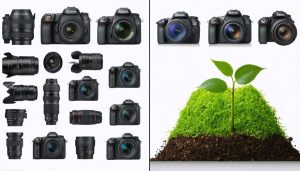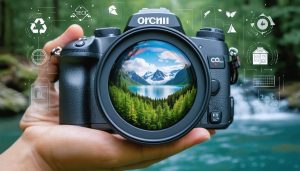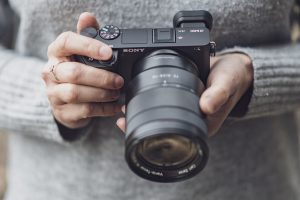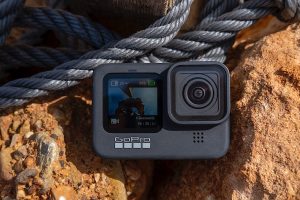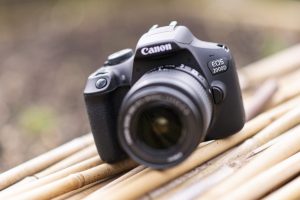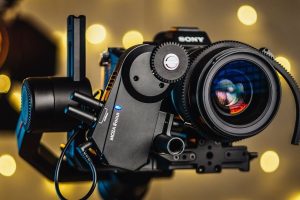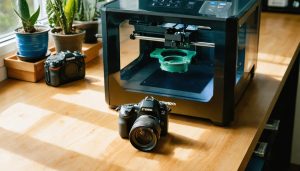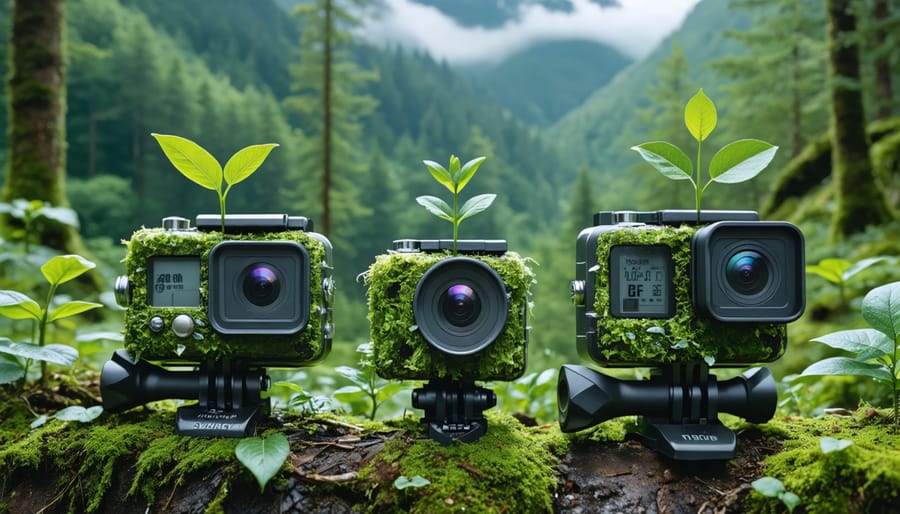
Transform your adventure photography with wearable action cameras – the ultimate tools for capturing immersive, hands-free footage while maintaining sustainable photography practices. These compact powerhouses have revolutionized how we document everything from extreme sports to daily adventures, offering perspectives that were once impossible to achieve.
Gone are the days when capturing dynamic action meant risking expensive equipment or missing the moment entirely. Today’s wearable cameras combine rugged durability with sophisticated image stabilization and environmental resistance, allowing creators to focus on the experience while ensuring every heart-pounding moment is preserved in stunning detail.
Whether you’re a professional athlete documenting your latest feat, an adventure enthusiast sharing your explorations, or simply someone who wants to capture life’s dynamic moments hands-free, wearable action cameras represent the perfect intersection of technology, creativity, and practicality. As these devices continue to evolve with improved battery life, enhanced connectivity, and more sustainable manufacturing processes, they’re becoming increasingly essential tools for modern visual storytelling.
What Makes an Action Camera Sustainable?
Materials and Manufacturing
Modern wearable action cameras are increasingly embracing sustainable materials and manufacturing processes. Leading manufacturers now incorporate recycled ocean plastics into their camera bodies and mounts, with some models featuring up to 35% recycled materials. The lens housing typically uses aerospace-grade aluminum, which is both durable and recyclable, while protective cases often utilize bio-based plastics derived from renewable resources.
Manufacturing facilities are making significant strides in reducing their environmental impact. Several major producers have transitioned to renewable energy sources for their production lines, while others have implemented closed-loop water systems that recycle up to 95% of water used in manufacturing. Advanced precision manufacturing techniques also help minimize material waste during production.
Packaging has seen a dramatic shift toward sustainability. Many brands now use plastic-free packaging made from recycled cardboard and soy-based inks. Protective foam inserts are being replaced with molded pulp trays, while user manuals are increasingly available in digital format to reduce paper waste. Some manufacturers have even introduced biodegradable lens caps and protective covers, demonstrating their commitment to reducing single-use plastics in the industry.
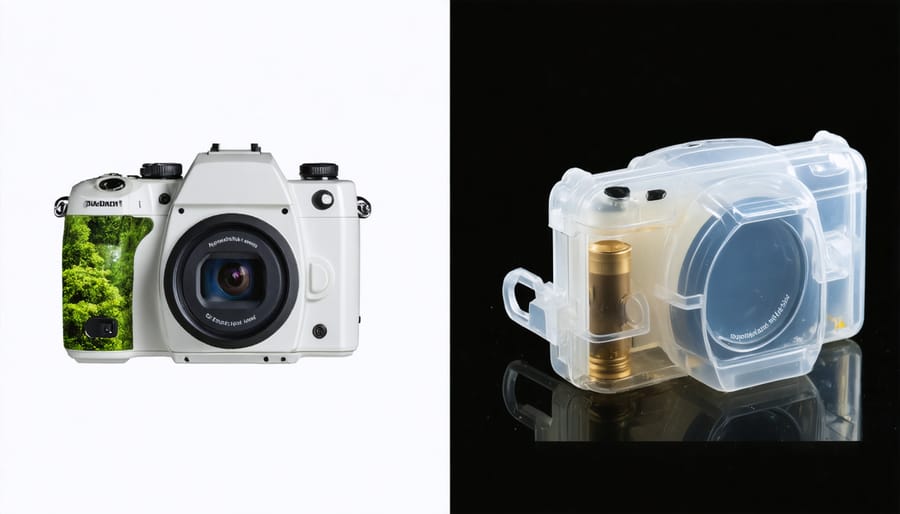
Energy Efficiency and Battery Life
Battery life remains one of the most crucial factors in wearable action cameras, often determining the success or failure of a shooting session. Modern action cameras typically offer 2-3 hours of continuous recording at 1080p, though this can drop significantly when shooting in 4K or using features like image stabilization and GPS.
Manufacturers are implementing various power-saving technologies to extend battery life. Smart recording features automatically pause when there’s no movement, while adjustable screen brightness and auto-shutdown options help conserve power during idle periods. Some models now incorporate efficient processors and optimized firmware that reduce power consumption without compromising performance.
The latest lithium-ion batteries used in premium action cameras feature quick-charging capabilities, typically reaching 80% capacity in about an hour. For extended shoots, many photographers carry spare batteries or portable power banks. Some newer models even support USB-C power delivery, allowing for continuous recording while connected to an external power source.
To maximize battery life, consider shooting at lower resolutions when ultra-high quality isn’t necessary, and disable features like WiFi and Bluetooth when not in use. Keeping your camera’s firmware updated also ensures you benefit from the latest power optimization improvements.
Top Sustainable Action Cameras in 2024
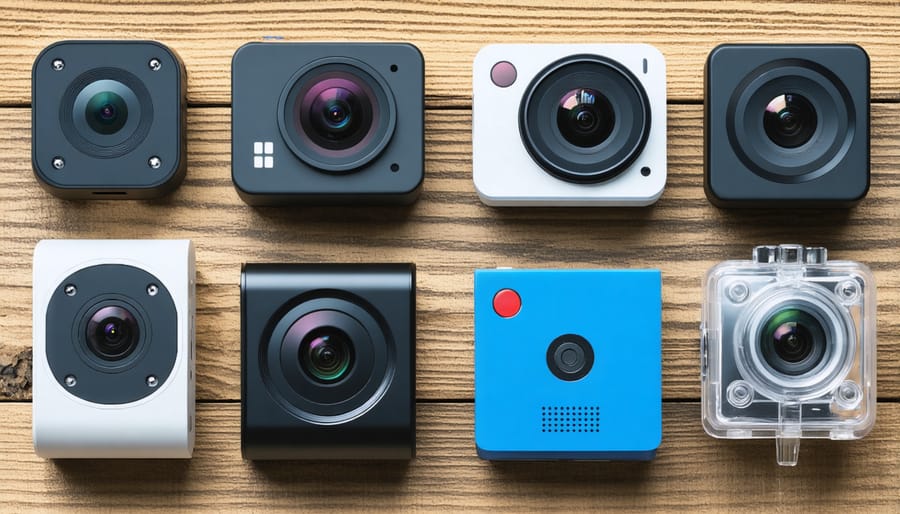
Recycled and Recyclable Models
As sustainability becomes increasingly important in consumer electronics, several eco-friendly camera manufacturers are leading the charge with recyclable action cameras. These innovative models incorporate recycled materials while maintaining the durability and performance expected from action cameras.
GoPro’s latest HERO11 Black includes 35% post-consumer recycled plastic in its housing, while their packaging is now 94% plastic-free. The camera’s modular design allows for easy parts replacement, extending its lifespan and reducing electronic waste.
DJI Action 4 features a removable battery system and incorporates recycled aluminum in its frame construction. The company has also implemented a take-back program, accepting old devices for proper recycling and parts recovery.
Insta360’s GO 3 stands out with its minimal packaging approach and use of recycled materials in both the camera body and mounting accessories. The compact design reduces material usage while maintaining functionality.
When shopping for sustainable action cameras, look for:
– Percentage of recycled materials used
– Modular design for repairs
– Clear end-of-life recycling instructions
– Minimal packaging
– Extended warranty programs
– Available replacement parts
These features not only benefit the environment but often result in more durable products that provide better long-term value. Many manufacturers now include recycling guides and pre-paid shipping labels for proper disposal when the camera reaches the end of its life cycle.
Remember that choosing recyclable models isn’t just about the materials – it’s about supporting brands committed to reducing their environmental impact while delivering high-quality imaging tools.
Energy-Efficient Champions
In the realm of action cameras, battery life can make or break your adventure documentation. Several manufacturers have made significant strides in power efficiency, delivering impressive performance without constant battery anxiety.
The GoPro Hero11 Black leads the pack with its revolutionary Enduro battery technology, offering up to 40% longer runtime compared to standard batteries. When shooting at 4K/60fps, users can expect around 2 hours of continuous recording – perfect for those extended mountain biking sessions or surf adventures.
DJI’s Action 4 showcases exceptional power management through its intelligent battery system. The camera automatically adjusts settings based on temperature and usage patterns, extending battery life while maintaining optimal performance. In extreme cold conditions, its specialized battery chemistry ensures reliable operation down to -20°C.
For the ultra-endurance focused, the Insta360 X3 deserves special mention. Its replaceable battery design combined with power-efficient processors delivers up to 81 minutes of continuous 5.7K recording. The camera’s “Power Reserve” mode can extend standby time up to 24 hours, ensuring you never miss that perfect moment.
Notable mention goes to the AKASO Brave 7 LE for its innovative dual-battery system. Users can hot-swap batteries without powering down the camera, effectively doubling recording time. Each battery provides approximately 90 minutes of 4K recording, making it an excellent choice for extended shooting sessions.
Remember that actual battery performance varies based on recording settings, environmental conditions, and feature usage. Using built-in power-saving modes, carrying spare batteries, and optimizing your settings can significantly extend your shooting time in the field.
Extending Your Camera’s Lifespan
Maintenance Best Practices
Proper maintenance is crucial to extend your gear’s lifespan and ensure optimal performance of your wearable action camera. Start by cleaning the lens after each use with a microfiber cloth, being particularly careful to remove any saltwater residue or debris that could cause long-term damage.
Keep your camera’s firmware updated to access the latest features and bug fixes. Many performance issues can be resolved with a simple update. Store your camera in a dry, temperature-controlled environment when not in use, and always use the protective case during transport.
Battery care is essential – avoid completely draining the battery, and store it at around 40% charge if you won’t be using the camera for an extended period. Regularly inspect and clean the battery contacts to prevent corrosion.
Pay special attention to the seals and gaskets if your camera is waterproof. These components can deteriorate over time, so check them before any underwater use and replace them according to the manufacturer’s recommendations. Keep spare lens covers handy, as scratched glass can significantly impact your footage quality.
Remember to format your memory cards regularly through the camera’s menu rather than your computer, and always keep your mounting hardware properly tightened to prevent accidents during action shots.
Sustainable Accessories
As action camera enthusiasts become more environmentally conscious, manufacturers are responding with eco-friendly accessories that don’t compromise on protection or functionality. Leading the charge are cases made from recycled ocean plastics and biodegradable materials, offering the same durability as traditional options while reducing environmental impact.
Cork-based mounting systems have emerged as a sustainable alternative to plastic mounts, providing excellent grip and shock absorption while being naturally renewable. Some manufacturers are also introducing bamboo selfie sticks and chest harnesses made from recycled PET bottles, proving that sustainability doesn’t mean sacrificing performance.
For protection against the elements, several brands now offer protective cases made from plant-based materials that are both water-resistant and biodegradable. These cases typically decompose within 2-3 years in proper composting conditions, compared to hundreds of years for traditional plastic cases.
When shopping for sustainable accessories, look for certifications like Global Recycled Standard (GRS) or Forest Stewardship Council (FSC) to ensure environmental claims are legitimate. Many manufacturers are also minimizing packaging waste by using recycled cardboard and soy-based inks.
Remember that sustainable doesn’t always mean more expensive. While some eco-friendly accessories may cost slightly more upfront, they often offer superior durability, potentially saving money in the long run while helping protect our environment.
Responsible Disposal and Upgrades
Trade-in and Recycling Programs
When it’s time to upgrade your wearable action camera, several responsible disposal options can help minimize environmental impact while potentially saving you money. Major manufacturers like GoPro and DJI offer trade-in programs that provide substantial discounts on new models when you return your old device. GoPro’s Trade-Up program, for instance, typically offers up to $100 off new flagship models when you send in any working digital camera.
Many electronics retailers have also established recycling initiatives for action cameras and their accessories. Best Buy accepts most action cameras for recycling at no cost, while B&H Photo and Adorama run seasonal trade-in events with competitive valuations. These programs ensure that valuable materials like lithium batteries, sensors, and precious metals are properly recycled.
For cameras that still work but you no longer need, consider donation programs that support environmental education or outdoor recreation nonprofits. Organizations like Cameras For Kids Foundation and The Photo Foundation accept action camera donations to support their educational initiatives.
Before disposing of your camera, remember to remove all personal data, including WiFi passwords and GPS locations. Also, check if your camera’s manufacturer offers battery recycling programs separately, as lithium batteries often require special handling. Some manufacturers even provide prepaid shipping labels for sending in old devices, making the recycling process completely hassle-free.
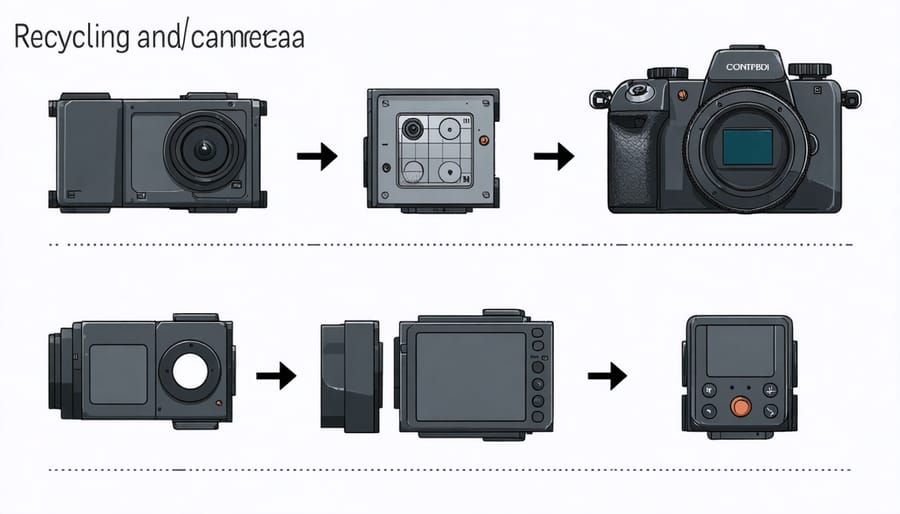
When to Upgrade vs. Repair
Making the decision between upgrading or repairing your action camera requires careful consideration of multiple factors. A good rule of thumb is to evaluate both the age of your device and the nature of any issues you’re experiencing.
Consider upgrading when your camera is more than three years old and showing significant performance limitations, such as deteriorating battery life, outdated video resolution, or incompatibility with current accessories. If you’re frequently bumping against technical limitations that affect your creative output, like insufficient frame rates or poor low-light performance, an upgrade might be justified.
However, many common issues can be effectively resolved through repairs. Problems like damaged lens covers, weak battery connections, or corrupted firmware are typically fixable at a fraction of the cost of a new camera. When your device is less than two years old and the repair cost is under 40% of a new model’s price, repairing is usually the more sustainable choice.
Before making your decision, assess whether the upgrade offers meaningful improvements for your specific needs. For instance, if you primarily shoot daytime activities at 1080p, a 4K upgrade might not justify the environmental impact of replacing your current camera. Consider selling or donating your old device if you do upgrade, ensuring it continues to serve a purpose rather than contributing to electronic waste.
Remember to factor in the availability of repair parts and service support for your current model when making your decision. Some manufacturers maintain better long-term support than others, which can significantly impact the longevity of your investment.
As we’ve explored throughout this article, wearable action cameras have revolutionized the way we capture and share our adventures. These versatile devices have become essential tools for creators, athletes, and enthusiasts alike, offering unprecedented freedom to document life’s most exciting moments from unique perspectives.
However, with this technological advancement comes responsibility. As photographers and content creators, we have a duty to consider the environmental impact of our gear choices. By investing in durable, high-quality action cameras, maintaining them properly, and disposing of old equipment responsibly, we can minimize our ecological footprint while maximizing our creative output.
Remember to prioritize features that truly matter for your specific needs rather than chasing the latest releases. Consider factors like battery life, durability, and repair options when making your purchase decision. Regular maintenance, proper storage, and careful handling will extend your camera’s lifespan significantly.
When upgrading becomes necessary, explore trade-in programs or donate working equipment to educational programs. If disposal is inevitable, research local e-waste recycling facilities that properly handle electronic components.
By embracing these sustainable practices while pursuing our passion for action photography, we can continue capturing incredible moments without compromising our planet’s future. After all, the environments we love to photograph deserve our protection and respect.
Let’s move forward with conscious choices that benefit both our creative pursuits and the world around us.

